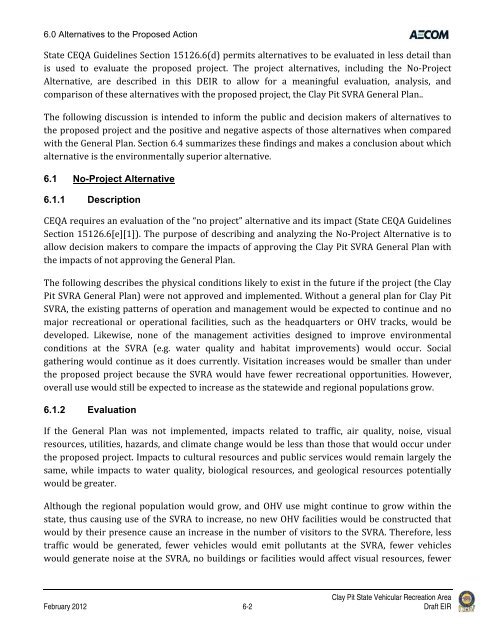Draft Environmental Impact Report - California Off Highway Vehicle ...
Draft Environmental Impact Report - California Off Highway Vehicle ...
Draft Environmental Impact Report - California Off Highway Vehicle ...
Create successful ePaper yourself
Turn your PDF publications into a flip-book with our unique Google optimized e-Paper software.
6.0 Alternatives to the Proposed Action<br />
State CEQA Guidelines Section 15126.6(d) permits alternatives to be evaluated in less detail than<br />
is used to evaluate the proposed project. The project alternatives, including the No‐Project<br />
Alternative, are described in this DEIR to allow for a meaningful evaluation, analysis, and<br />
comparison of these alternatives with the proposed project, the Clay Pit SVRA General Plan..<br />
The following discussion is intended to inform the public and decision makers of alternatives to<br />
the proposed project and the positive and negative aspects of those alternatives when compared<br />
with the General Plan. Section 6.4 summarizes these findings and makes a conclusion about which<br />
alternative is the environmentally superior alternative.<br />
6.1 No-Project Alternative<br />
6.1.1 Description<br />
CEQA requires an evaluation of the “no project” alternative and its impact (State CEQA Guidelines<br />
Section 15126.6[e][1]). The purpose of describing and analyzing the No‐Project Alternative is to<br />
allow decision makers to compare the impacts of approving the Clay Pit SVRA General Plan with<br />
the impacts of not approving the General Plan.<br />
The following describes the physical conditions likely to exist in the future if the project (the Clay<br />
Pit SVRA General Plan) were not approved and implemented. Without a general plan for Clay Pit<br />
SVRA, the existing patterns of operation and management would be expected to continue and no<br />
major recreational or operational facilities, such as the headquarters or OHV tracks, would be<br />
developed. Likewise, none of the management activities designed to improve environmental<br />
conditions at the SVRA (e.g. water quality and habitat improvements) would occur. Social<br />
gathering would continue as it does currently. Visitation increases would be smaller than under<br />
the proposed project because the SVRA would have fewer recreational opportunities. However,<br />
overall use would still be expected to increase as the statewide and regional populations grow.<br />
6.1.2 Evaluation<br />
If the General Plan was not implemented, impacts related to traffic, air quality, noise, visual<br />
resources, utilities, hazards, and climate change would be less than those that would occur under<br />
the proposed project. <strong>Impact</strong>s to cultural resources and public services would remain largely the<br />
same, while impacts to water quality, biological resources, and geological resources potentially<br />
would be greater.<br />
Although the regional population would grow, and OHV use might continue to grow within the<br />
state, thus causing use of the SVRA to increase, no new OHV facilities would be constructed that<br />
would by their presence cause an increase in the number of visitors to the SVRA. Therefore, less<br />
traffic would be generated, fewer vehicles would emit pollutants at the SVRA, fewer vehicles<br />
would generate noise at the SVRA, no buildings or facilities would affect visual resources, fewer<br />
Clay Pit State Vehicular Recreation Area<br />
February 2012 6-2 <strong>Draft</strong> EIR








